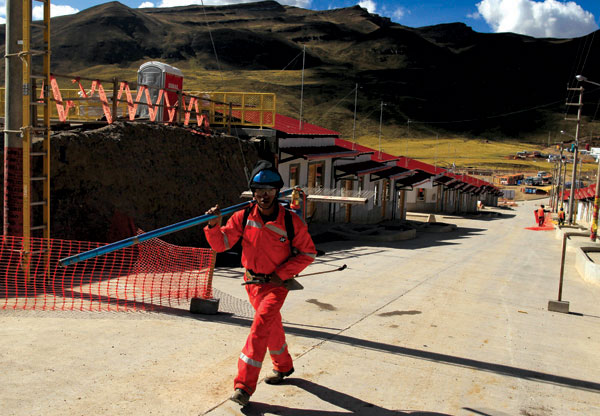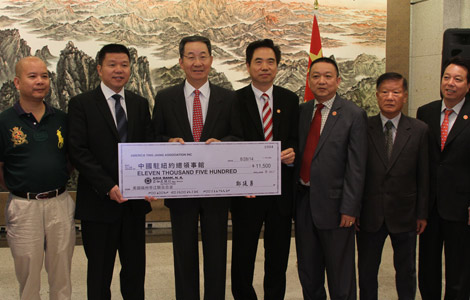Copper mining deal strengthens China-Peru ties
Updated: 2014-09-01 04:15
By Zhang Yuchen in Beijing(China Daily Latin America)
|
||||||||
 |
|
A worker carries materials for the construction of houses in the new town named "New Morococha," in the Andean city of Junin in June, 2012. [REUTERS/Pilar Olivares] |
A recent copper deal between China and Peru will make the South American country the world's second-largest producer of the metal and symbolizes the strengthening of ties between two countries.
Peru is set to replace China as the world's second-largest copper miner, behind neighbouring Chile, because of a $20-billion pipeline of Chinese mining projects, according to senior officials in Lima, the Financial Times reported on Aug 25.
Commercial links between China and Peru were reinforced in July by the $7 billion acquisition of Glencore's Las Bambas copper mine by China Minmetals' MMG subsidiary. That deal means Chinese investors are behind one-third of all of Peru's new mining investments by value, estimated by the country at $61 billion, the newspaper reported.
US companies have been among the biggest investors in Peruvian mining, but Chinese projects in the country are now worth more than those from the US and Canada combined, according to the the FT.
Peru aims to increase copper production by 1.2 million tons by 2016, according to Guillermo Shinno, deputy mining minister in Lima, which will move it past China.
"We have excellent relations with the Chinese; China has evolved as a partner. There is more openness, not only at a financial level, [but] also at trade and social responsibility levels," Eleodoro Mayorga, Peru's energy and mining minister, said in an interview with the newspaper.
Jose Miguel of the Peru Association of Mining, Oil and Energy said that in the last three years average annual copper mining production costs rose by 20 percent, according to a Peruvian business newspaper, but that production costs in 2014 are expected to increase by only 8 percent.
According to the FT, other Chinese mining investments in Peru include Chinalco's $4.82 billion Toromocho copper mine, which is currently undergoing an expansion; Minmetals and Jiangxi's $2.5-billion El Galeno, a copper, gold and silver project; a $1.5-billion enlargement of an iron ore mine by Shougang Hierro Peru in Marcona; and Jinzhao Mining's planned $3.28-billion investment in Pampa de Pongo, another iron ore mine.
The growth of bilateral relations between China and Peru in other areas of cooperation was cited in July by Juan-Miguel Miranda, minister counselor at the Embassy of Peru, at the celebration of 193rd anniversary of the establishment of the Republic de Peru in July. In 2013, the annual volume of bilateral trade reached $15 billion, he said.
China is the world's largest consumer of copper with current consumption representing 17 percent of the global total, and the largest copper concentrate importer.
A report by the Chinese Academy of Social Sciences titled World Energy Outlook: China (2013-2014), said that China will increasingly depend on foreign sources to meet its energy needs, with the amount from outside sources rising from the current 9 percent of total energy demand to 11 percent in 2015, and close to 26 percent in 2020.
Oil imports will increase by 60 percent in 2015, according to the report, and natural gas imports will increase by about 35 percent in 2015 from the current 19 percent, and by nearly 40 percent in 2020.
"Under the influence of multiple factors, the pattern of world energy resources is undergoing major new changes," wrote Zhang Monan, a member of the International Association for Chinese Management Research, in a recent analysis in the quarterly China Economy Report, published by the Development Research Center of the State Council.
"Energy resource constraints will be a key influence to strengthen the sustainable development of China's economy," she wrote.
zhangyuchen@chinadaily.com.cn

 Peace Mission - 2014 military drill ends in China's Inner Mongolia
Peace Mission - 2014 military drill ends in China's Inner Mongolia
 First steps on a journey of discovery
First steps on a journey of discovery
 Garbage dump turns water into poison
Garbage dump turns water into poison
 Vintage cars exhibition opens in Jinan
Vintage cars exhibition opens in Jinan
 Discussion on Chinese FDI
Discussion on Chinese FDI
 Boeing, Xiamen Airlines celebrate 787 Dreamliner delivery
Boeing, Xiamen Airlines celebrate 787 Dreamliner delivery
 US photographer captures amazing starry night
US photographer captures amazing starry night
 More earthquake relief rolls in
More earthquake relief rolls in
Most Viewed
Editor's Picks

|

|

|

|

|

|
Today's Top News
US launches fresh air strikes on IS rebels
NPC decision a landmark in HK democratic development
Chui Sai On elected Macao chief executive-designate
Exhibition on China-US WWII collaboration unveiled
Google building delivery drones
US, China plan followup to Sunnylands summit
US urged to stop recon
Bay Area takes lessons from Napa quake
US Weekly

|

|







